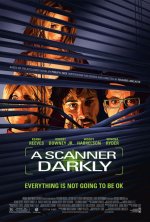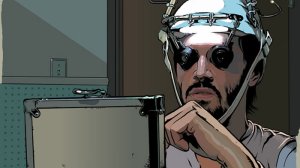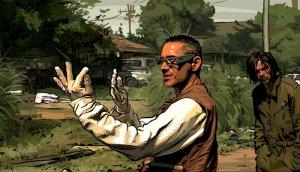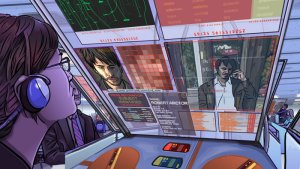 |
|
At The Picture Show
|
July 2006

What does a 'Scanner' see?
Linklater's 'A Scanner Darkly' is an uneven paranoid jumble, but nicely captures the essence of Philip K. Dick
A Scanner Darkly
Warner Independent Pictures
Director: Richard Linklater
Screenplay: Richard Linklater, based on the novel by Philip K. Dick
Starring: Keanu Reeves, Robert Downey Jr., Winona Ryder, Rory Cochrane and Woody
Harrelson
Rated R / 1 hour, 40 minutes
Opened July 14, 2006



 (out of four)
(out of four)
There are no tangible villains in A Scanner Darkly, nor any prototypical heroes. There are
figures of death, corruption, depression, societal decay…but nothing is exactly black and white.
There are no easy answers -- which should be par for the course for anything faithfully based on
the work of Philip K. Dick.
In the case of A Scanner Darkly -- based on Dick's novel of the same name -- the
"villains" are bureaucracy and overbearing government, and the heroes are narcs and drug
addicts borne of a sad and corrupt American wasteland. It is "seven years from now" in Orange
County, California, and about 20 percent of the U.S. population is addicted to drugs -- most
notably the dangerously addictive "Substance D." As one character puts it, "There are no
weekend warriors with Substance D -- you're either on it, or you've never tried it."
 We meet Bob Arctor, a former family man who lost it all
once he got hooked on the stuff. His nice suburban home has now been turned into a pseudo-drug den, where he lives with two fellow addicts, James Barris (Robert Downey Jr., in another
great performance) and Ernie Luckman (Woody Harrelson). The three also get frequent visits
from Charles Freck (Rory Cochrane), another addict who is probably worse off than any of
them, and Donna (Winona Ryder), Bob's kinda-sorta girlfriend.
We meet Bob Arctor, a former family man who lost it all
once he got hooked on the stuff. His nice suburban home has now been turned into a pseudo-drug den, where he lives with two fellow addicts, James Barris (Robert Downey Jr., in another
great performance) and Ernie Luckman (Woody Harrelson). The three also get frequent visits
from Charles Freck (Rory Cochrane), another addict who is probably worse off than any of
them, and Donna (Winona Ryder), Bob's kinda-sorta girlfriend.
But Bob Arctor is also "Fred," a narc for a bureaucratic "volunteer-only" anti-drug
organization called New Path. He goes undercover, trying to weed out users and pushers on the
street while wearing a "scramble suit" -- which basically makes him look like a blur to passers-by. The suit shuffles between about 1.5 million different faces and bodies, making Bob's true
identity nearly impossible to decipher.
 Of course, Bob has the same problem -- even he can't
decipher his true identity. One of the side-effects of Substance D is a sort of brain damage which
causes a split personality. And so when Fred is assigned to spy on Bob Arctor, he doesn't seem
to realize -- at least not fully -- that he is narcing on himself.
Of course, Bob has the same problem -- even he can't
decipher his true identity. One of the side-effects of Substance D is a sort of brain damage which
causes a split personality. And so when Fred is assigned to spy on Bob Arctor, he doesn't seem
to realize -- at least not fully -- that he is narcing on himself.
From the scramble suit itself to the hallucations, distortions and dream sequences that
frequently pop up, A Scanner Darkly is a difficult story to put on film. What makes it possible is
the way it has been done. Indie writer/director Richard Linklater (Before Sunrise/Sunset, Dazed
and Confused, The School of Rock) has used the same "interpolated rotoscoping" process that he
used in 2001's Waking Life, which was the first-ever full-length feature to use such a process.
The film is shot digitally, with live actors and sets, and then animated over the live shots to
create a unique combination of reality and animation. The overall effect is one of a distorted
reality -- and what better visual style for a story that is about that very thing?
True to many of Dick's futuristic worlds, A Scanner Darkly's Orange County circa 2013
is a paranoid one, and it is that which Linklater captures best. We experience that paranoia and
fear right along with the characters.
In a brilliant sequence, a heavily addicted Freck turns on the radio, only to hear the
announcer narrating, in the past tense, how Freck is going to kill himself -- with every last
detail. And so Freck, hearing this, follows the radio announcer's narrative to a T. The
proceedings are tremendously funny.
 The rotoscoping only enhances the film's mood -- from
bedrooms to freeways to office buildings, everything is visually distorted. One's surroundings
are moving, floating, ever so slightly -- we can easily understand the characters' feelings of
dizziness or confusion, because we're seeing it right with them.
The rotoscoping only enhances the film's mood -- from
bedrooms to freeways to office buildings, everything is visually distorted. One's surroundings
are moving, floating, ever so slightly -- we can easily understand the characters' feelings of
dizziness or confusion, because we're seeing it right with them.
As a storyline, however, A Scanner Darkly never really congeals. This might be fitting
for this type of film and this type of universe, but it makes for an uneven viewing experience.
Couldn't the ideas and the storyline been more coherently merged? There are times when it is
easy to get lost (particularly at the end) and there are certain logical questions that go needlessly
unanswered.
A Scanner Darkly has been classified as a thriller, but that's hardly accurate. There is
virtually no action, and the film isn't concerned with an overly rigid plot. And the suspense and
mystery are of the psychological variety. This is more cerebral than your typical thriller -- a
talky and philosophical examination of a paranoid and pseudo-dystopian universe. So while
"thrills" may be few and far between, the ideas presented take precedent. And in this case, that's
a good thing.
Read more by Chris Bellamy